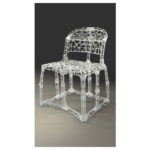Architecture and Digital Fabrication students at ETH Zurich have devised a new method for creating concrete components using ice formworks, addressing the surplus ice generated during ice rink resurfacing. Known as Cold Production, this approach leverages digitally sculpted ice as a mold material, employing spatial concrete lattices and stacking principles.

There are actually two molds involved in the process. First, a 3D printed plastic mold is produced, and then the ice is pressed into the mold, forming the ice formwork. After pouring and curing the concrete, elements are taken out of the -10°C laboratory, and left outdoors for demolding, allowing the ice to melt away and reveal intricate lattice designs.

Utilizing 8400 kg of ice sourced from local rinks, this large-scale production method minimizes energy consumption and enhances production speed. The intertwined geometries of the concrete elements enable continuous structure assembly.
Cold Production builds upon the Ice Formwork project, highlighting ice’s potential to cast concrete in complex forms. This innovative approach not only repurposes surplus ice but also advances the field of digital fabrication in architecture.
Source: core77.com
Come and let us know your thoughts on our Facebook, X, and LinkedIn pages, and don’t forget to sign up for our weekly additive manufacturing newsletter to get all the latest stories delivered right to your inbox.










